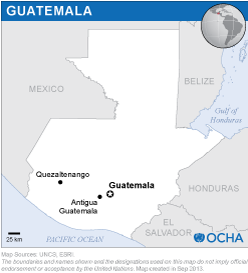In recent decades, Guatemala has been experiencing disasters triggered by geologic and hydro-meteorological hazards that have impacted urban and rural communities. In order to increase the country’s capacity to make use of to address these hazards, UN-SPIDER, in conjunction with the National Secretariat of the Council of Science and Technology of Guatemala (SENACYT) and the Executive Secretariat of National Coordinating Agency for Disaster Reduction of Guatemala (SE-CONRED) held three-day training for a technical inter-institutional team. The training took place at the GIS Laboratory of the Faculty of Agriculture of San Carlos University (USAC), Guatemala City.
Agustin Codazzi Geographic Institute (IGAC), Colombia
Federal University of Santa Maria, Rio Sul, Brazil
Members of the inter-institutional technical team that was set up by CONRED at the recommendation of UN-SPIDER.
During the three-day training, the inter-institutional technical team was trained on how to use remote sensing techniques and UN-SPIDER Recommended Practices on droughts and forest fires as a way to generate relevant and timely geospatial information that is useful for disaster risk reduction, preparedness and emergency response efforts. The training segment on the UN-SPIDER Recommended Practices focusing on droughts was geared to contribute to the implementation of the “Strengthening Early Warning Systems for Drought” (SEWS-D) project. Carried out in El Salvador, Dominican Republic, Guatemala and Honduras, the project aims to incorporate the use of drought indicators targeting the status of vegetation as a way to complement data generated by meteorological departments on rainfall and weather. The training built on earlier efforts of UN-SPIDER to increase the capacity of the National Coordinating Agency for Disaster Reduction of Guatemala (CONRED) and other government agencies to take advantage of the opportunities provided by the space community. UN-SPIDER recommended these government agencies the establishment of a technical inter-institutional team that would focus its efforts on the generation of geospatial information extracted from space and in situ data as a way to contribute to disaster risk reduction, preparedness and emergency response efforts related to different types of events. An initial technical team was established in July 2012 with five institutions. The training course contributed to the establishment of a larger team that will integrate other government agencies, as well as several universities.

